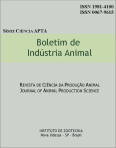Different nutritional recommendations for broilers: performance and economic analysis
DOI:
https://doi.org/10.17523/bia.v71n4p350Palavras-chave:
aves, frango, custo, proteína bruta, energiaResumo
The objective of this research was to compare the effect of different nutritional recommendations on the performance and economics of the production of broiler chickens. A total of 1,200 Cobb-500 line male broilers were placed in a completely randomized design with four treatments and 10 replicates, with 30 animals each. The diets in each treatment were as follows: 1. COBB-VANTRESS (2009); 2. Commercial feed; 3. Rostagno et al. (2005); and 4. Rostagno et al. (2011). The following performance traits were evaluated: feed intake (FI), weight gain (WG), body weight (BW), feed conversion (FC) and productive efficiency index (PEI). The experiment ran while chickens were 1 to 21 and 1 to 42 days old. For the economic analysis, the diet cost and live weight price were considered when calculating the average cost of the diet (ADC) and the gross trading margin (TM). Analysis of variance was used to evaluate ADC and TM performance traits; diets means were compared with Tukey€™s test. In the 1 to 21 day period, there was a higher FI and less efficient FC with diet 1 and more efficient PEI with diet 4. During the 1 to 42 day period, diets 1, 3 and 4 had the highest BW, WG and PEI. TM and ADC show similar results, i.e., commercial feed being less attractive to producers. For the entire experimental period, the nutritional recommendations of COBB-VANTRESS (2009), Rostagno et al. (2005) and Rostagno et al. (2011) had the highest productive and economic performance for broiler production.Downloads
Downloads
Publicado
Edição
Seção
Licença
Os autores não serão remunerados pela publicação de trabalhos, pois devem abrir mão de seus direitos autorais em favor deste periódico. Por outro lado, os autores ficam autorizados a publicar seus artigos, simultaneamente, em repositórios da instituição de sua origem, desde que citada a fonte da publicação original seja Boletim de Indústria Animal. A revista se reserva o direito de efetuar, nos originais, alterações de ordem normativa, ortográfica e gramatical, com vistas a manter o padrão culto da língua e a credibilidade do veículo. Respeitará, no entanto, o estilo de escrever dos autores. Alterações, correções ou sugestões de ordem conceitual serão encaminhadas aos autores, quando necessário. Nesses casos, os artigos, depois de adequados, deverão ser submetidos a nova apreciação. As opiniões emitidas pelos autores dos artigos são de sua exclusiva responsabilidade. Todo o conteúdo deste periódico, exceto onde está identificado, está licenciado sob a Licença Creative Commons Attribution (CC-BY-NC). A condição BY implica que os licenciados podem copiar, distribuir, exibir e executar a obra e fazer trabalhos derivados com base em que só se dão o autor ou licenciante os créditos na forma especificada por estes. A cláusula NC significa que os licenciados podem copiar, distribuir, exibir e executar a obra e fazer trabalhos derivados com base apenas para fins não comerciais.













